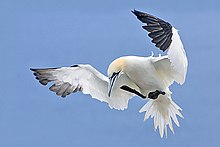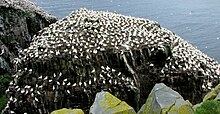
| Home | Sources Directory | News Releases | Calendar | Articles | | Contact | |
Northern Gannet
| Northern Gannet | |
|---|---|
 |
|
| Conservation status | |
| Scientific classification | |
| Kingdom: | Animalia |
| Phylum: | Chordata |
| Class: | Aves |
| Order: | Pelecaniformes |
| Family: | Sulidae |
| Genus: | Morus |
| Species: | M. bassanus |
| Binomial name | |
| Morus bassanus (Linnaeus, 1758) |
|
 |
|
| Northern Gannet range | |
| Synonyms | |
|
Sula bassana |
|
The Northern Gannet (Morus bassanus) is a seabird and is the largest member of the gannet family, Sulidae.
Contents |
[edit] Description
Young birds are dark brown in their first year, and gradually acquire more white in subsequent seasons until they reach maturity after five years.
Adults are 81'110 cm (32'43 in) long, weigh 2.2'3.6 kg (4.8'7.9 lbs) and have a 165'180 cm (65'71 in) wingspan. Before fledging, the immature birds (at about 10 weeks of age) can weigh more than 4 kg (8.8 lbs). Their plumage is white with black wing tips. The bill is light bluish. The eye is light blue, and it is surrounded by bare, black skin. During breeding, the head and neck are brushed in a delicate yellow.
[edit] Distribution
Their breeding range is the North Atlantic. They normally nest in large colonies, on cliffs overlooking the ocean or on small rocky islands. The largest colony of this bird, with over 60,000 couples, is found on Bonaventure Island, Quebec, but 68% of the world population breeds around the coasts of Great Britain, with the largest colonies on the Bass Rock (whence the species' Latin name) and Boreray, St Kilda.
In the United Kingdom, gannets are a protected species. However, a legal exception is made for the inhabitants of the town of Ness (also known as Port Nis) of the Isle of Lewis who are allowed to kill up to 2000 gannets (locally known as guga) annually to serve as a traditional local delicacy'the taste is described as fishy.[1][2]
Many of these gannets are taken from Sula Sgeir which is itself named after them.

[edit] Ecology
Gannet pairs may remain together over several seasons. They perform elaborate greeting rituals at the nest, stretching their bills and necks skywards and gently tapping bills together.
They are migratory and most winter at sea, heading further south in the Atlantic.
These birds are spectacular divers, plunging into the ocean at high speed. Although they are pul and agile fliers, they are clumsy in takeoffs and landings. They mainly eat small fish (2.5'30.5 cm in length) which gather in groups near the surface. Virtually any small fish (roughly 80'90% of the diet) or other small pelagic species (largely squid) will be taken opportunistically. Various cod, smelt, and herring species are most frequently taken.[4]
Although Northern Gannet populations are now stable, their numbers were once greatly reduced due to loss of habitat, removal of eggs and killing of adults.
Predators of eggs and nestlings include Great Black-backed and Herring Gulls, Common Ravens, ermine, and red fox. The only known natural predator of adults is the Bald Eagle, though large sharks and seals may rarely snatch a gannet out at sea.[5]
Old names for the Northern Gannet include Solan, Solan Goose, and Solant Bird.
[edit] Photo gallery
|
Northern Gannets at Gaspé Peninsula, Quebec |
Northern Gannet on Helgoland |
||
|
Northern Gannet on Bonaventure Island, Quebec |
|||
|
Northern Gannet at the Norwegian bird-island Runde |
Sula Sgeir showing Northern Gannet colony and guano |
Gannet colony on Stac Lee |
Gannet on kelp close to Keflavik, Iceland |
[edit] References
- ^ Culture Hebrides - Island holidays in the Gaelic Heartland of Scotland The Rough Guide to Scottish Highlands and Islands
- ^ [1]
- ^ Cramp, Stanley., K. E. L. Simmons (1977). Handbook of the birds of Europe, the Middle East, and North Africa : the birds of the Western Palearctic. ISBN 0198573588.
- ^ http://bna.birds.cornell.edu/bna/species/693/articles/foodhabits
- ^ http://bna.birds.cornell.edu/bna/species/693/articles/behavior
- BirdLife International (2004). Morus bassanus. 2006. IUCN Red List of Threatened Species. IUCN 2006. www.iucnredlist.org. Retrieved on 9 May 2006. Database entry includes justification for why this species is of least concern
[edit] External links
| Wikimedia Commons has media related to: Northern Gannet |
- Northern Gannets Pictures from Faroe Islands
- BTO BirdFacts - Northern Gannet
- Northern Gannet videos, photos & sounds on the Internet Bird Collection
- Northern Gannet Photographs South Dakota Birds and Birding
- Stamps
- Northern Gannet photo gallery VIREO
- Northern Gannets Pictures
|
SOURCES.COM is an online portal and directory for journalists, news media, researchers and anyone seeking experts, spokespersons, and reliable information resources. Use SOURCES.COM to find experts, media contacts, news releases, background information, scientists, officials, speakers, newsmakers, spokespeople, talk show guests, story ideas, research studies, databases, universities, associations and NGOs, businesses, government spokespeople. Indexing and search applications by Ulli Diemer and Chris DeFreitas.
For information about being included in SOURCES as a expert or spokesperson see the FAQ . For partnerships, content and applications, and domain name opportunities contact us.














